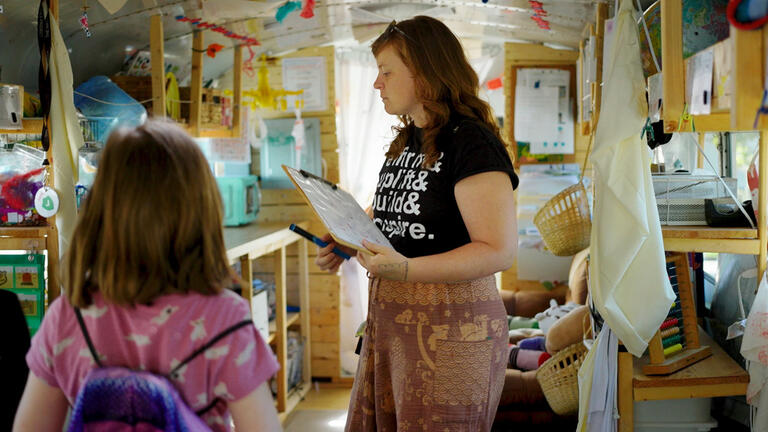Most schools follow the same rhythm: five days a week, six hours a day, in the same building. But at Solstice Hybrid Academy in Norfolk, Virginia, the classroom has wheels and a schedule that bends to fit the lives of families.
Founder Sarah Harrington, a former public school teacher, launched the mobile microschool to challenge the one-size-fits-all model she saw holding kids back. Her goal? Make learning personal, purposeful, and portable. Today, Solstice students spend mornings on a converted school bus diving into hands-on lessons, then take their learning into the world where they explore libraries, nature trails, museums, farms, and parks.
The school is built on a simple belief: Families should have the freedom to choose how, when, and where their children learn best.
Today, Solstice is a reinvention of what Harrington believes education can be — a space of joy, hands-on learning, and deep connections with a flexible schedule to meet families where they are.
The result is a school that offers students — ages 5 through 10 — two to five days a week of project-based, personalized learning, with afternoons spent applying what they learn.
This is education — reimagined.
This is what school should feel like
By the time Harrington decided to leave her public school classroom, she wasn’t burned out; she was fired up. An elementary school art teacher with a passion for hands-on learning, she tried to make public education more immersive, more creative, and more connected to real life. But over time, she hit a wall.
“I was trying to use art as a tool to make connections to math, science, and history,” Harrington said. “But I only had 45 minutes at a time with students. And it was back-to-back with no room to breathe or build real relationships.”
The tipping point came during the pandemic. Harrington was tutoring her niece and nephew and juggling remote teaching with caring for her young son. But to her surprise, what started as a means to an end began to work better than pre-pandemic school.
“We’d do packets in the morning, then buckle up and go somewhere and explore different places that made learning real,” Harrington said. “That’s when I realized: This is what school should feel like. Putting all that knowledge into practice in a real-life situation, an immersive environment where they are problem-solving and using those techniques and skills to create things.”
Harrington knew many families were also experiencing challenges with traditional school models — whether it was a lack of one-on-one attention due to crowded classrooms or lesson plans that didn’t align with their child’s learning style.
When her son reached pre-K age and faced barriers to enrollment in their district, the frustration turned into fuel. “I wanted to teach him in a meaningful way — and I realized I wasn’t alone. Other families were having the same issues. That’s when I said, ‘I’m opening my own school.’”
School doesn’t have to be five days a week
The Solstice model is rooted in the belief that learning should be personal, purposeful, and portable. At Solstice, families choose the schedule that works for them — whether that’s a couple of days a week or a full week of immersive learning. This is because parents know best how their children learn and thrive.
“I had to unschool myself a bit,” Harrington admitted. “School doesn’t have to be five days a week, six-and-a-half hours a day. At Solstice, we build schedules that work for each family.”
The mornings are spent on the bus engaging in independent learning, with a focus on one subject each day. Students also learn theater, fine arts, homesteading, and life skills such as effective communication, financial management, time management, and decision-making.
In the afternoons, the bus roars to life and kids are transported to a field trip destination for hands-on projects and real-world learning. Students might practice math at an art museum, explore science at a racetrack, or write stories at the beach. Each field trip is designed to help students live the lessons they’re taught — not just sit through them — and ignite a love of learning.

In addition to the mobile classroom, Solstice’s schedule is one of its most distinctive benefits. Some students attend five days a week, while others attend a couple of days a week to complement their homeschooling. Others come just for the field trips. And Solstice’s bus doors are open year-round to accommodate families’ schedules or provide additional learning during summer break.
“We have parents who work full time and need structure. Others are flexible and want community. This gives them some autonomy over how school fits into their lives,” Harrington explained.
Sign up for Stand Together's K-12 newsletter and get stories, ideas, and advice from changemakers who are transforming education across the country.
How does school on a bus work?
Harrington admits that the Solstice model may seem unusual at first. She regularly fields questions like, “How do you teach kids on a bus?” Or “Are the academics rigorous?” But Harrington is prepared for skepticism. Part-time students complete academic work at home to complement their studies at Solstice. All families and teachers meet quarterly to assess progress and set learning goals, and students can take an end-of-year assessment to demonstrate their progress to the state. Students’ end-of-year portfolios are also reviewed by licensed educators and combined in a summative report documenting their time at Solstice.
Harrington added that Solstice’s model can be ideal for students with ADHD or those who have trouble sitting behind a desk for hours. “They need to get out and get moving,” she said. “They need that hands-on experience, and if that’s your child, this is probably going to work out for them. They’re going to grow so much.”
The mobile classroom itself also offers real-world learning moments that teach the students resilience and confidence.
“There are a lot of moving parts with a mobile classroom, and things may not go according to plan,” Harrington said. “But we go with it, and the kids learn that when things go wrong, they can figure it out and persevere.”
A complement, not a competitor
Harrington stresses that she didn’t create Solstice to compete with traditional educational models. She designed it to complement them. More models mean more opportunities to meet parents and students where they are.
“Solstice is just one model, and this is what learning looks like at our school,” Harrington said. “If this sounds good and it’s your jam, then join the party. And if it’s not, that’s OK, too. I want there to be more options so that parents have educational autonomy for their children.”
She hopes that more options like Solstice will reduce the strain on traditional systems — allowing teachers to focus on the students who need them most.
“We don’t need fewer schools. We need more,” Harrington said. “More models. More options. More ways to meet families where they are.”
One option for an alternative model
What Solstice is doing isn’t just innovative — it’s reframing what one type of school can be. It’s not the solution to every family’s challenges, but it does offer an option to approach education in a way that may work better for them. And it reimagines what school looks like: academic success doesn’t only have to be measured by tests, and learning doesn't have to happen in a building with four walls.
“Parents want their kids to love learning,” Harrington said. “They want them to be curious, confident, and capable. That’s what we’re building.”
While Solstice is still young, Harrington has goals for expansion — more buses, more staff, maybe even a mentorship program for other educators who are ready to leap into alternative education models.
“Our model works for our families,” she said. “It’s financially sound, it’s emotionally supportive, and it’s academically strong. I want more people to know that they can do this, too.”
Solstice Hybrid Academy is supported by VELA, which as part of the Stand Together community supports everyday entrepreneurs who are boldly reimagining education.
Learn more about Stand Together's education efforts and explore ways you can partner with us.

At this summer camp, kids don’t just have fun — they’re challenged.

Can a gamified education platform help kids love learning and save teachers time?

This gathering of the country’s largest network of education founders shows what’s possible.

This resource is empowering education innovators to turn their visions into reality.
